Winterizing Your Conveyor System: Safeguard Operations All Season Long
When looking at your conveyor belt system, there are a couple of tasks that often go overlooked when it comes to maintaining good health for the system as a whole. One of these maintenance tasks that is frequently forgotten until it is too late is the winterization of the conveyor belt. Winterizing the conveyor system can prove critical in keeping material moving efficiently and safely. As temperatures drop below freezing, material can begin to clog chutes, lump into larger piles, and cause slip hazards.

To properly winterize your conveyor belt, there are several steps you can take to be prepared as the temperatures lower.
Conveyor Belt De-Icer
Having conveyor belt de-icer on hand can be the determining factor in whether you are able to run your system on any given cold weather day. As temperatures begin to freeze, conveyor belts become rigid and lose their ability to trough in idlers as well. When conveyors don’t trough properly, this can cause them not to carry material in the center of the belt, leading to material spillage along walkways and onto the ground below. This is not only a concern due to the loss of material but also poses many safety concerns for personnel around conveyors. The primary solution for keeping conveyor belts flexible and running is de-icer. When properly applied, de-icer keeps ice from forming along the conveyor line and lowers the temperature at which the material will form large clumps. When ice is not given the chance to form on a conveyor system, a conveyor belt is more likely to maintain good friction with pulleys and idlers, keeping the belt running efficiently and properly.
Proper Cleaning
When evaluating a system for winterization, a maintenance department can look at how the system acts during the warmer months to help predict what needs to be addressed before winter arrives. If material tends to build up inside a chute in warmer months, most of the time this material can easily be washed out. However, when this problem is ignored in the winter months, it can cause large chunks of material to fall onto the conveyor below the chute. When larger, harder material clumps fall onto conveyor belts not designed to handle this material build-up, damage can occur to the belt and conveyor components, leading to costly repairs needed in an immediate time span. By ensuring that proper cleaning is occurring in chutes and on the conveyor belts using cleaner blades in the winter, companies can be safer in how they operate when temperatures turn freezing.

Don’t forget: environmentally friendly belt deliver is readily available from Thaman Rubber stock!